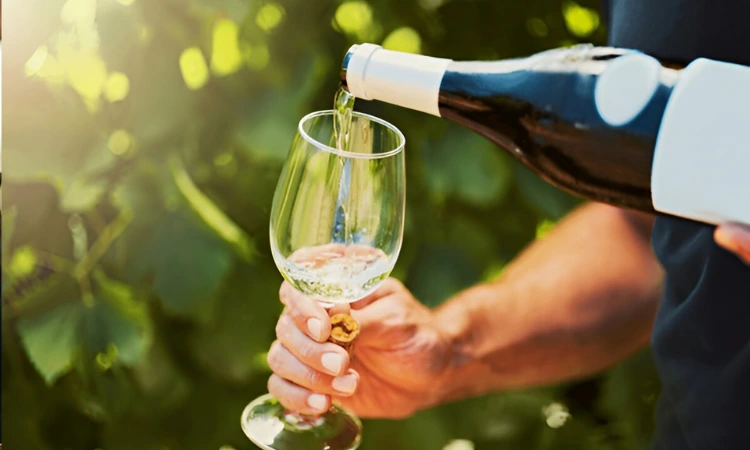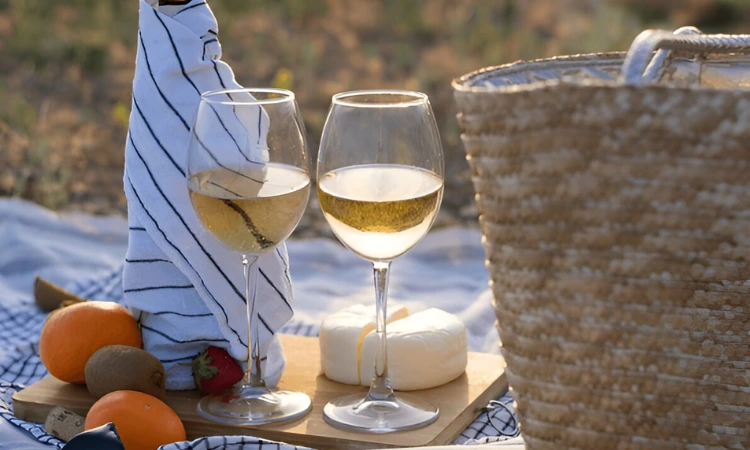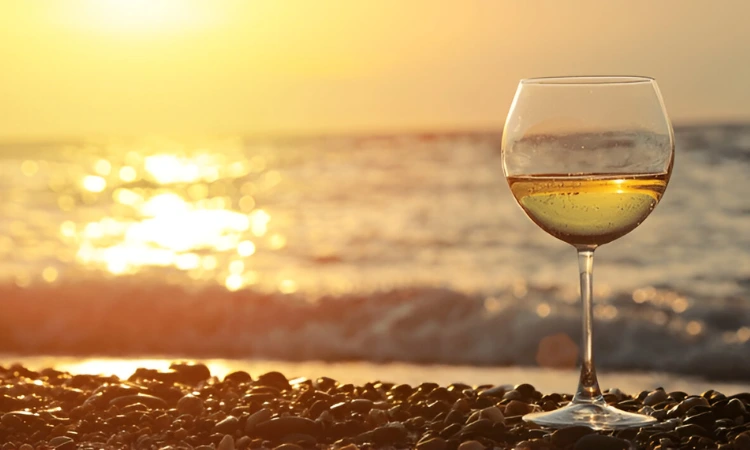Ever wondered what does Chardonnay wine taste like? You’re not alone! Chardonnay is one of the most popular white wines, yet its flavor can confuse even regular wine drinkers.
Is it sweet or dry? Why do some taste buttery and creamy while others feel crisp and zesty? Don’t worry—we’re breaking it down in the simplest way possible.
This guide will walk you through the Chardonnay flavor profile and help you finally understand the taste of Chardonnay wine without the wine jargon.
Whether you’re a total beginner or just curious, you’ll get clear answers right from the first sip.
What is Chardonnay?
Chardonnay is a popular white wine made from one of the most widely planted white grape varieties worldwide.
Known for its versatility, Chardonnay can offer a range of white wine tastes—from light and crisp to rich and buttery—depending on how it’s produced.
This grape thrives in famous wine regions like France, California, and Australia, making Chardonnay a global favorite.
Whether you prefer a refreshing or creamy style, Chardonnay is a wine that suits many occasions and tastes.
Is Chardonnay Sweet or Dry?

Most Chardonnay wines are considered dry and have little to no residual sugar. So, if you’re wondering, is Chardonnay sweet?—The simple answer is usually no.
However, Chardonnay can sometimes taste sweet because of its natural fruitiness, like apple or peach flavors, or from oak aging, which adds vanilla and buttery notes.
This sweetness is actually “perceived sweetness,” not actual sugar. Understanding these Chardonnay characteristics helps you enjoy why some wines feel richer or softer without being truly sweet.
Chardonnay Flavor Profile
When exploring Chardonnay taste, the profile often includes fresh apple flavor, juicy pear undertones, and bright citrus notes like lemon or grapefruit. In warmer climates, you might also notice hints of ripe peach.
Depending on where the grapes are grown, these flavors change—cooler regions produce crisper, more citrus-driven wines, while warmer areas bring out richer, fruitier tastes.
For those new to wine, Chardonnay tasting notes for beginners reveal a balanced mix of fresh fruit and smooth vanilla from oak aging, making it approachable and enjoyable.
Oaked vs Unoaked Chardonnay – A Huge Flavor Difference

One of the biggest differences in Chardonnay wine taste comes from whether it’s oaked or unoaked.
Unoaked Chardonnay is crisp and fresh, with bright citrus flavors and green apple notes that feel light and zesty.
Oaked Chardonnay is aged in oak barrels, giving it rich, buttery flavors, along with vanilla and toast. This creamy texture is often a result of malolactic fermentation, which softens the wine’s acidity.
Whether you prefer fresh and tangy or smooth and rich, both styles offer deliciously different Chardonnay characteristics.
What Makes Some Chardonnays Buttery?
Why is Chardonnay buttery sometimes? It’s primarily due to a process called malolactic fermentation (MLF).
In simple terms, MLF turns sharp, green apple acids into softer, creamier ones, giving the wine a smooth, buttery feel.
Aging Chardonnay in oak barrels adds to this creaminess by infusing flavors like vanilla and toast. MLF and oak aging create that rich, buttery taste many people love.
This combination of fermentation and barrel aging works its magic to make Chardonnay buttery.
Chardonnay Tasting Notes for Beginners
For anyone just starting to explore wine, getting to know the tasting notes of Chardonnay is simpler than you might think. Chardonnay can range from light-bodied and zesty to creamy and full, depending on how it’s made.
It often has medium to high acidity, giving it a refreshing feel. Expect layered flavors like green apple, citrus, pear, vanilla, and toast in oaked versions.
This flavor layering makes Chardonnay interesting and versatile. Whether crisp or rich, Chardonnay always offers something for every kind of wine lover to enjoy.
How Climate Change Affects Chardonnay’s Taste

Climate and wine flavor go hand in hand, especially with Chardonnay. In cooler climates like Burgundy, Chardonnay is crisp, with sharp acidity and citrus notes—think lemon and green apple.
It becomes fuller-bodied in warmer climates, such as California or Australia, often showing tropical fruit flavors like pineapple and mango. The terroir of each wine region plays a significant role in how the wine turns out.
Whether you prefer Burgundy Chardonnay or a rich, buttery California Chardonnay, knowing the climate helps you pick the right bottle. These differences make Chardonnay truly diverse and exciting.
Best Food Pairings with Chardonnay
Chardonnay is a versatile wine that pairs well with a wide range of dishes.
Unoaked Chardonnay, with its crisp acidity and fresh citrus notes, goes perfectly with seafood, green salads, and soft cheeses like goat cheese.
On the other hand, oaked Chardonnay has a rich, creamy texture that matches beautifully with roasted chicken, creamy pasta, and mushroom-based dishes. The wine’s flavor adapts to the food, enhancing both the drink and the meal.
Whether light or full, there’s a Chardonnay to complement just about any plate you choose.
Smell of Chardonnay: What Your Nose Tells You

Ever asked yourself what does Chardonnay smell like? The aroma of Chardonnay is one of its most inviting traits.
In unoaked versions, you might notice fresh scents of green apple, pear, and citrus. Oaked Chardonnay brings richer notes like vanilla, butter, and a light toastiness.
These smells preview the wine’s flavor, since aroma and taste work closely together. Before sipping, take a slow sniff—your nose will often tell you what to expect in each delicious glass of Chardonnay.
Buttery Chardonnay vs Sweet Chardonnay
Many people confuse a buttery Chardonnay with a sweet wine, but they’re totally different.
Buttery refers to texture and flavor from oak aging and malolactic fermentation, not sugar content. Most Chardonnays are actually dry.
Here’s a quick breakdown:
- Buttery Chardonnay: Creamy, smooth, vanilla, toasted notes
- Sweet Chardonnay: Rare, often labeled as “late harvest” or dessert wine
- Regular Chardonnay: Dry, fruity, balanced acidity
Understanding this helps you pick the right wine for your taste!
Is Chardonnay Good for Beginners?
“If you’re wondering, is Chardonnay good for beginners? The answer is absolutely. Chardonnay wine is a great starting point for wine beginners.
It’s very approachable and offers a wide range of flavors depending on where it’s made and how it’s aged. It pairs easily with food—whether you’re having seafood, chicken, or pasta.
If you’re new to wine, start with an unoaked Chardonnay. It’s light, crisp, and fresh, making it easier to enjoy and understand.
You can explore richer, oaked versions for more depth and complexity as your taste develops.
Chardonnay Wine Alcohol Level

Chardonnay wines typically have an alcohol content ranging from 13% to 14.5% ABV (alcohol by volume). This can vary depending on the wine region and the ripeness of the grapes.
Warmer climates like California often produce wines with slightly higher alcohol levels due to riper grapes, while cooler regions like Burgundy usually result in wines with a slightly lighter alcohol content.
Overall, Chardonnay offers a balanced alcohol level that complements its rich flavors without overpowering the palate.
Choosing a Good Bottle of Chardonnay Wine
Picking a great bottle of Chardonnay can feel overwhelming, but here’s what I’ve learned from personal experience.
First, consider your preferred style—do you like crisp and refreshing or rich and buttery?
When I started, I loved the light, unoaked versions because they were easy to drink and paired well with almost any meal. Over time, I explored oaked Chardonnays for their creamy texture and vanilla notes.
Also, check the wine region—California and Burgundy offer excellent choices. Trust your nose and taste buds—they’ll guide you to your perfect bottle!
What Does Chardonnay Wine Taste Like? FAQs for Curious Sippers
What does Chardonnay wine taste like?
Depending on how it’s made, chardonnay tastes range from crisp and citrusy to rich and buttery. Its flavors often include apple, pear, vanilla, and tropical fruit.
Is Chardonnay sweet or dry?
Most Chardonnay wines are dry with little residual sugar, though natural fruitiness or oak aging can give a perception of sweetness. It’s not usually a sweet wine unless labeled.
Is Chardonnay light or full-bodied?
Chardonnay can be both—unoaked versions tend to be light-bodied and crisp, while oaked Chardonnays are usually full-bodied and creamy. The style depends on production methods and region.
Can Chardonnay be aged?
Yes, Chardonnay can age well, especially those from cooler climates with good acidity. Aging often enhances complexity, developing richer, nuttier, and more layered flavors.
What glass suits Chardonnay?
A medium-sized white wine glass with a narrower rim works best for Chardonnay. It helps concentrate aromas and balances the wine’s acidity and creamy textures.
What makes Chardonnay taste buttery?
The buttery flavor comes mainly from malolactic fermentation, which softens acidity and adds creamy texture. Oak barrel aging also contributes vanilla and toast notes.
What foods pair best with Chardonnay?
Unoaked Chardonnay pairs well with seafood and salads, while oaked versions complement creamy dishes like roasted chicken or pasta. Its versatility suits many light to rich meals.
How does oak affect Chardonnay’s taste?
Oak aging adds vanilla, toast, and spice notes, giving Chardonnay a richer, creamier mouthfeel. It also smooths acidity, creating a more luscious wine style.
Why does Chardonnay taste different from region to region?
Climate and soil influence grape ripeness and flavor, with cooler regions producing crisper wines and warmer areas yielding fruitier, fuller-bodied Chardonnays. Terroir shapes the wine’s character.
Is Chardonnay good for beginners?
Absolutely! Chardonnay’s range of styles from light and fresh to rich and creamy makes it approachable for new wine drinkers. Start with unoaked for easy, crisp flavors.
The Bottom Line
Now that you know precisely what does Chardonnay wine taste like, you’re ready to sip with confidence.
Chardonnay is full of surprises from its crisp citrus notes in cooler climates to the rich, buttery layers of an oaked bottle.
Whether you’re new to wine or growing your collection, this white wine offers endless variety.
Don’t be afraid to try different regions or styles—every glass is a step in understanding your own taste. So go ahead, pour a glass, and enjoy the journey.

